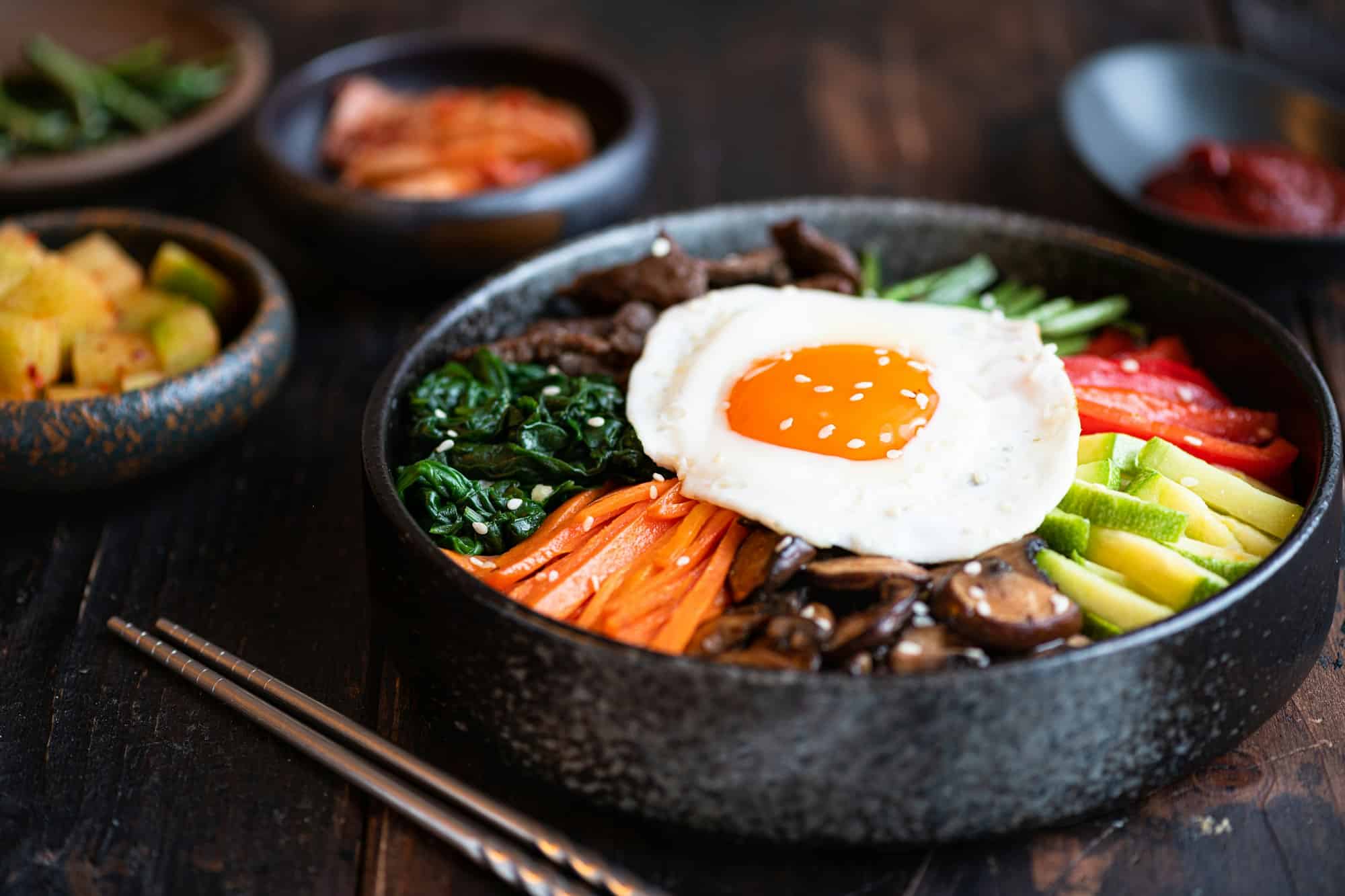Bibimbap, a staple in Korean cuisine, is a vibrant and hearty rice bowl filled with a colorful assortment of fresh and cooked vegetables, juicy beef, a tasty fried egg, and a dollop of spicy gochujang sauce. The literal translation of Bibimbap is "mixed rice." With each ingredient carefully prepared and thoughtfully assembled, the dish becomes an edible work of art that is as pleasing to the eye as it is to the palate. Today we are going to learn how to create a flavorful Korean Bibimbap with authentic gochujang sauce that will surely awaken your taste buds.
The Art of Preparing Bibimbap
Preparing bibimbap requires patience, care, and a delicate balance of flavors. It begins with the rice. Ideally, you should use short-grain Korean rice as it has a sticky consistency that holds the ingredients together. If you can’t find Korean rice, sushi rice or any other sticky rice variety will do. You should rinse the rice thoroughly until the water runs clear, then cook it according to package instructions. The goal is to achieve a tender yet slightly chewy texture that is neither too dry nor too wet.
Cela peut vous intéresser : What’s the Secret to a Perfectly Smooth Japanese Katsu Curry Sauce?
Next, let’s move onto the vegetables. Traditional bibimbap includes ingredients like spinach, bean sprouts, carrots, zucchinis, mushrooms, and radishes. Each vegetable should be cooked separately to preserve its unique flavor. Some are blanched, while others are sautéed with a touch of sesame oil and a pinch of salt.
The beef is another essential component of bibimbap. For an authentic Korean taste, marinate thinly sliced beef in a mixture of soy sauce, sugar, garlic, and sesame oil before cooking. The result is a juicy, flavorful meat that perfectly complements the vegetables and rice.
A lire en complément : Can You Bake a Perfect Canadian Butter Tart with a Flaky Pastry Shell?
Mastering the Gochujang Sauce
The soul of bibimbap lies in its sauce, the gochujang sauce. This spicy red pepper paste is a staple in Korean cuisine and gives bibimbap its distinctive heat. Making gochujang sauce at home is quite simple, and the result is a sauce that is far superior to anything you can buy in a store.
To make gochujang sauce, you’ll need the following ingredients:
- 3 tbsp gochujang paste
- 1 tbsp sesame oil
- 1 tbsp sugar
- 1 tbsp water
- 1 teaspoon vinegar
- 1 teaspoon minced garlic
Combine all the ingredients in a bowl and mix until well combined. You can adjust the sweetness or spiciness to your preference by adding more sugar or gochujang paste. This sauce can be stored in a clean jar in the refrigerator for up to a month.
Assembling Your Bibimbap
Assembling your bibimbap is where the fun really begins. Start by placing a generous amount of rice at the bottom of a bowl. Then, arrange your cooked vegetables and beef on top of the rice. Try to create a contrast of colors for a visually appealing dish.
Next, add a fried egg on top. The egg is often cooked sunny side up, but you can prepare it according to your preference.
Lastly, add a generous dollop of your homemade gochujang sauce. The sauce should be added just before eating. To eat, mix all the ingredients together until the sauce is evenly distributed throughout the bowl. The combination of the hot, sticky rice, the crunchy vegetables, the savory beef, and the fiery gochujang sauce creates an explosion of flavors and textures in every bite.
Tips for a Perfect Bibimbap
Creating a perfect bibimbap takes time and practice, but here are a few tips to help you along the way. First, always use fresh, high-quality ingredients. The quality of your ingredients will significantly impact the overall taste of your dish.
Second, don’t be afraid to experiment with different vegetables. Bibimbap is a versatile dish, and you can add any vegetables you like.
Third, don’t skip the sesame oil. It adds a unique flavor that can’t be replicated by any other type of oil.
Lastly, don’t rush the cooking process. Take your time to properly cook each ingredient and assemble your bowl. Your patience and efforts will be rewarded with a delicious, flavorful bibimbap that is sure to impress.
With these instructions, you’re now equipped to create your own flavorful Korean Bibimbap with authentic gochujang sauce. Enjoy the process of preparing this dish as much as you will enjoy consuming it, and don’t be afraid to add your personal touch.
Achieving the Perfect Garnish and a Distinctive Dolsot Bibimbap
Enhancing your bibimbap with an array of garnishes and spices not only makes it more visually appealing but also adds depth to its flavor profile. Sesame seeds and toasted sesame oil are commonly used to garnish bibimbap. Lightly toasting the sesame seeds before sprinkling them over your dish can further elevate the flavor. Simply add them to a dry pan over medium heat, stirring occasionally until golden and fragrant.
If you want to take your bibimbap to the next level, you can turn it into a dolsot bibimbap. Dolsot means "stone pot" in Korean, and it refers to the hot stone bowl in which the bibimbap is served. To make a dolsot bibimbap, you only need to heat your stone bowl over high heat with a bit of sesame oil before adding in your ingredients. The heat from the bowl will create a crispy layer of rice at the bottom, adding a delightful crunch to your bibimbap.
There are also several other garnishes you can use, such as dried seaweed, green onions, or even a sprinkle of Korean chili powder for an extra kick. Remember, bibimbap is a versatile dish, so feel free to customize it according to your liking!
Conclusion: Experience the Joy of Authentic Korean Bibimbap at Home
In conclusion, creating a tasty and vibrant Korean bibimbap at home is a satisfying process that allows you to explore Korean cuisine. From preparing the perfect Korean rice and vegetables to mastering the authentic gochujang sauce recipe, every step imparts a unique flavor to your rice bowl.
The savory ground beef marinated in soy sauce and minced garlic, the crunch of bean sprouts, the sharpness of radish, and the heat from the gochujang sauce, all mixed together, creates an unforgettable culinary symphony of flavors. Whether you decide to garnish it with a sprinkle of sesame seeds, a drizzle of toasted sesame oil, or serve it in a sizzling stone bowl for a dolsot bibimbap experience, the result will be a hearty, flavorful dish that you and your loved ones can enjoy.
Remember, cooking bibimbap is an art, not a race. Take your time, enjoy the process, and play around with different ingredients and flavors. Once you’ve mastered the traditional bibimbap, don’t be afraid to mix it up and add your personal touch. The versatility of this dish means the possibilities are endless!
By following these instructions and tips, you are now ready to create, taste, and share a piece of Korean culinary heritage right from your kitchen. Enjoy your journey with Korean bibimbap!











